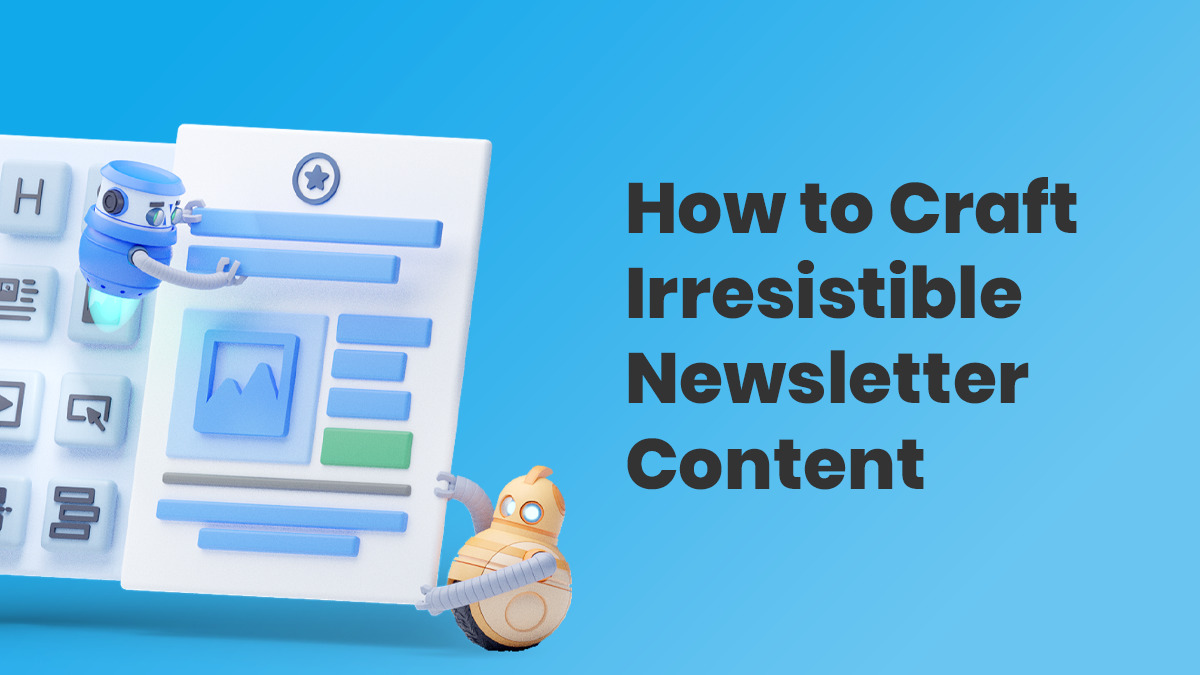
It’s no secret there is money in your email list. But just how much depends on you.
According to McKinsey & Company, the average employee spends 13 of their weekly working hours in their inbox. This is both good and bad news.
The good news is: Because people are spending so much time in their inboxes, you have an opportunity to make a big impact.
The bad news? More emails = dwindling attention spans.
You’ll need to get creative to break through the clutter of emails that loiter in your subscribers’ inboxes.
We’ll show you how to create an email newsletter that will keep your subscribers interested. Whether you want to improve your current newsletter or are researching ideas for your first one, these tried and true email marketing practices are sure to help.
(The most FUN way to succeed with email marketing? Everyday Email, a FREE email course. You'll get 30 short, easy-to-follow tips sent directly to your inbox for 30 days.)
What makes the best email newsletters?
What are the best email newsletters made of? Captivating copy, engaging visuals, and a clear call-to-action, right? Well, yes, but there’s more to it than that.
The number of emails flooding inboxes these days is staggering. According to DMR, the average person will get 121 emails per day (which is roughly 44,000 emails per year). That’s a lot to read.
Due to the sheer volume of emails people receive daily, it’s crucial to cater to your target audience.
So how do you ensure your emails are the brightest in the inbox? How do you know what newsletter content ideas will get read?
1. Give readers what they didn’t know they needed
The inbox is a sacred space. It’s a direct line into the lives of your audience and potential customers—so whatever you send should be of the highest quality.
Yes, creating an email newsletter free of grammatical errors and broken links is important. But providing actionable, helpful information to readers is also important. Bonus points if you provide knowledge or insight on something they didn’t know they needed. You want to build a relationship with your subscribers with great content — rather than pushing for a sale every single time.
For example: If you’re a business development coach looking to expand your newsletter readership, including extra content that your audience cares about (like a template or eBook or one of these 22 Brilliant Lead Magnets) is a good idea.
2. Encourage communication and request feedback
You wouldn’t walk into someone’s home with a megaphone and start blasting orders. So don’t do it in a subscriber’s inbox, either.
Start a conversation. Let them respond to you via email. Ask questions. Find out as much information about your readers as possible. What do they want from you?
Not only will your subscribers feel as if you are speaking directly to them, but their feedback will be invaluable to your business.
3. Keep readers reading with great newsletter copy and even better design
You can have the best written newsletter copy, but if it’s hard to read, it can be tough to get readers to stick around. We’re not suggesting that bad design mutes stellar copy, but striking a balance between the two is key when creating a quality email newsletter.
Related: How to Create Amazing Photos for Your Emails on Zero Budget
Take photo company Artifact Uprising for example. They're a visual company, which is clearly communicated across all marketing materials. In the example below, they stick with large, eye-catching images and bold, monochromatic colors.

But they don’t rely solely on bold, featured images. The copy, although simple, packs a punch — and it’s hard to resist clicking on the single CTA button to learn how to create your own beautiful photo book.
The copy and images in this example work together to tell a story. This is not a long email newsletter, but it didn’t need to be. It's chock full of value (an "insider's guide" and "tips and tricks"), and that’s what resonates with readers the most.
4. An email that reads well will be well read
Design doesn’t just mean pretty pictures. This is where readability comes into play. If you want readers to digest your content, make it easy to do so.
The Daily Carnage is a great example of strong layout and organization when it comes to email. It’s text-heavy, but in the best way. Bullet points, subheadings, and colorful call-to-actions make this email newsletter easy (and enjoyable) to read.
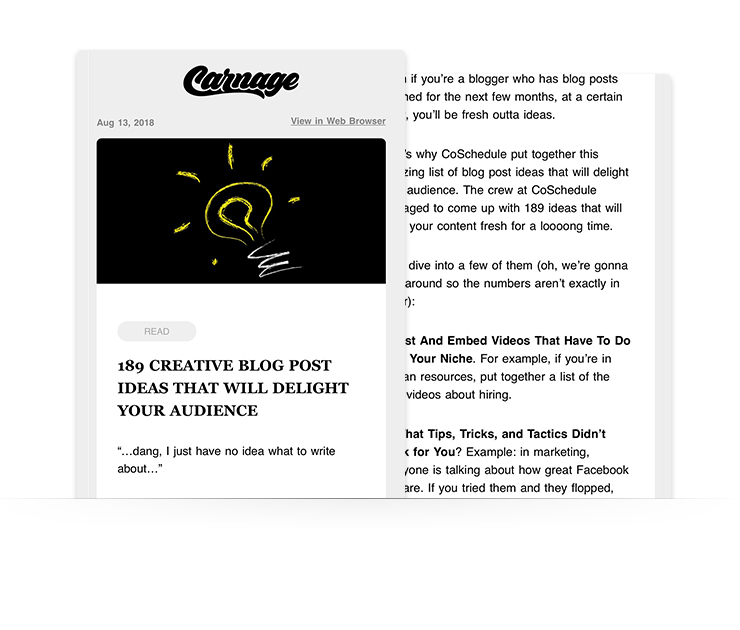
As with any writing, when it comes to the layout of your email newsletter, place the most important information at the top. Dwindling attention spans mean it’s critical to include important information first. The secondary details and other non-essential information come next.
If you see a block of text in the body of an email newsletter, what’s your first reaction? Delete? Scroll past? Chances are if you wouldn’t read it, neither would your subscribers.
Breaking the copy up into digestible paragraphs or bullet points will help your readers understand the message while saving them eye strain. The goal is to make the copy scannable, which is tough to do with large blocks of text.
An easy way to break up chunks of text: Use a zigzag or "z" pattern in your template. This design arrangement helps readers continue to move their way down an email, engaging with the imagery and content along the way. Think of it like a path for your reader to go down. It helps them make it to the end! (Inside AWeber, use the Flat-white and Gibson templates, which have alternating sections built in.)
Not sure what to write in your emails? We created a free course — What to Write in Your Emails — that comes with 45+ email writing templates!
5. Leverage your lists correctly
Segmentation is an excellent way to make your email newsletters more effective and to grow your customer base. According to the DMA, segmented and targeted emails generate 58% of all revenue.
With email segmentation, you can create lists of customers based on specific parameters you set and then customize campaigns for each.
For example, let’s say you want to target customers who have bought from you once but have not been back since that purchase. You can create a list of these customers and deploy an email campaign that works toward a sale conversion goal.
Rewarding customers for past purchases, sharing sale information, or encouraging customers to tell their friends about your brand are a few of the things you can do with a segmented list. Or you can categorize customers based on their email behavior (who opened/didn't open an email). Then, you can target each list differently, either educating them further on your business, or incentivizing them to buy with a unique offer.
Understanding what makes your lists unique is the key to using them effectively and seeing the ROI of your email newsletters over time.
Related: The Beginner's Guide to Making Money with Email Marketing
6. Treat your subscribers as individuals — not a nameless, faceless list
Before you send an email, stop and think about your list. No, not the size of your list. But the individuals on your list.
Like Chelsea, who reads your email during her 45-minute train commute to work.
Or Victor, who opens your email while he’s in the grocery store checkout line.
Or Kate, who scrolls through her inbox as her newborn son sleeps on her chest at 2 a.m.
Stop writing to a faceless crowd of subscribers. Instead, write to the individuals on your list. When you write to a single subscriber, they come alive in your mind. Your writing will go from drab to engaging. Generic to targeted. You’ll solve his or her problems. You’ll put the perfect product in front of him or her. You’ll make them want to open your next email.
And all your subscribers will feel as if you personally wrote the email to each of them. This is one of the most effective ways to find success with email marketing over the longterm.
How to best structure your email newsletter
The second your readers open your message, they immediately decide whether your email provides them enough value to act on your call to action or not.
The following three techniques show you how to structure your email newsletters so you provide clear value from the very first second.
1. Make your text scannable
As much as 77% of your subscribers may open your emails on their mobile devices, which means they're looking at your content in the palm of their hand. Long blocks of text that force your readers to scroll and scroll create a bad user experience. That's why you should break up your email copy into shorter, easier-to-read chunks.
Our advice: Keep email paragraphs to 2 to 3 sentences max.
Below are 6 more simple ways to make your emails more consumable on a phone — and you can do them all inside AWeber’s easy-to-use drag-and-drop email builder:
- Separate sections with headlines
- Add bullet points when listing multiple items or tips
- Include a button instead of hyperlinked text for your call to action (CTA)
- Use any of the hundreds of mobile-optimized templates inside AWeber
- Be concise (skip the run-on sentences, wordiness, jargon, buzzwords, and overly-difficult terms)
- For multiple articles, include only the first paragraph of each, and then link to the rest of the story
2. Include links for credibility
Adding research, data, studies, and quotes to your content is a compelling way to validate your points. However, you should always link to your reputable sources. If you mention a company or public figure, link to their web site.
Linking when appropriate has several benefits:
- your emails earn an extra layer of authority
- your readers get the extended value of the linked content
- it's a best practice on the web! When someone refers to your business or content, they should link to you, too.
3. Focus on one call to action
Choice is the enemy of conversion. If you give a person too many options, it makes it difficult for them to make a final decision, according to psychologist Barry Schwartz, who named this phenomenon “the paradox of choice.”
Want your readers to take an action inside your email (like sign up for a webinar)? Then point them to that one specific CTA with a large button (all other instances can be hypertext links). You shouldn't try to get them to also redeem a coupon, join your Facebook group, and book an appointment all in the same email. Your content should walk a subscriber down one path — don't give them multiple paths to choose from, or else you'll see little to no success.
Related: 8 Ways to Improve Your CTA Copy
When it comes to design vs. content, both matter
When creating an email newsletter, it’s easy to focus on either design or content. But the truth is: Both design and content are equally as important to the success of the campaign.
In fact, if an email includes too many images and not enough text, it can become problematic:
- Emails marked “image-only” may end up in the spam folder due to email service providers like Gmail filtering and blocking them.
- Subscribers may have disabled image viewing/downloading in their email settings.
- Depending on the internet connection and browser version, images can take longer than text to load. Subscribers may delete the email before the images have time to load.
So how can you be sure to strike a healthy balance between design and content in your email newsletter?
Let’s look at a few newsletter examples and break down what works well.
Design & Layout in Email Newsletters
1. Use the template that matches your goal
Are you sending out a discount code to new customers? Launching a new product? Announcing a huge end-of-the-season sale? There are many email templates to choose from, which can feel overwhelming at first. (AWeber has more than 700 mobile-responsive templates that you can use. Create your account today!)
The question is: Which one will be the best for the job?
For example, if you’re an AWeber user who wants to send a new discount code to new subscribers to show your appreciation and to get them to try a product, you might want to select a template that clearly indicates your message. Here's our "announcement" layout that you can customize for your business and brand.
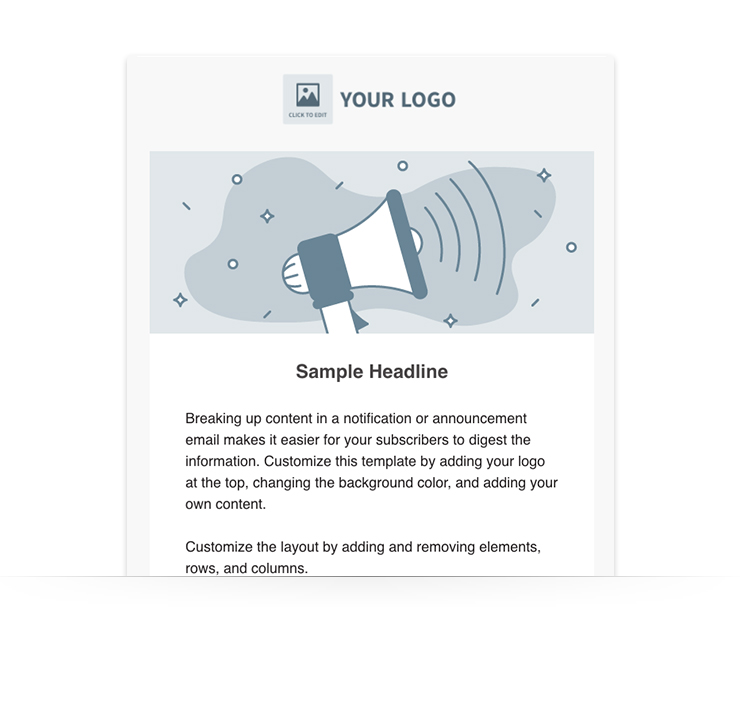
This Nike email does an excellent job of showing readers the detail of a product through visuals and copy:
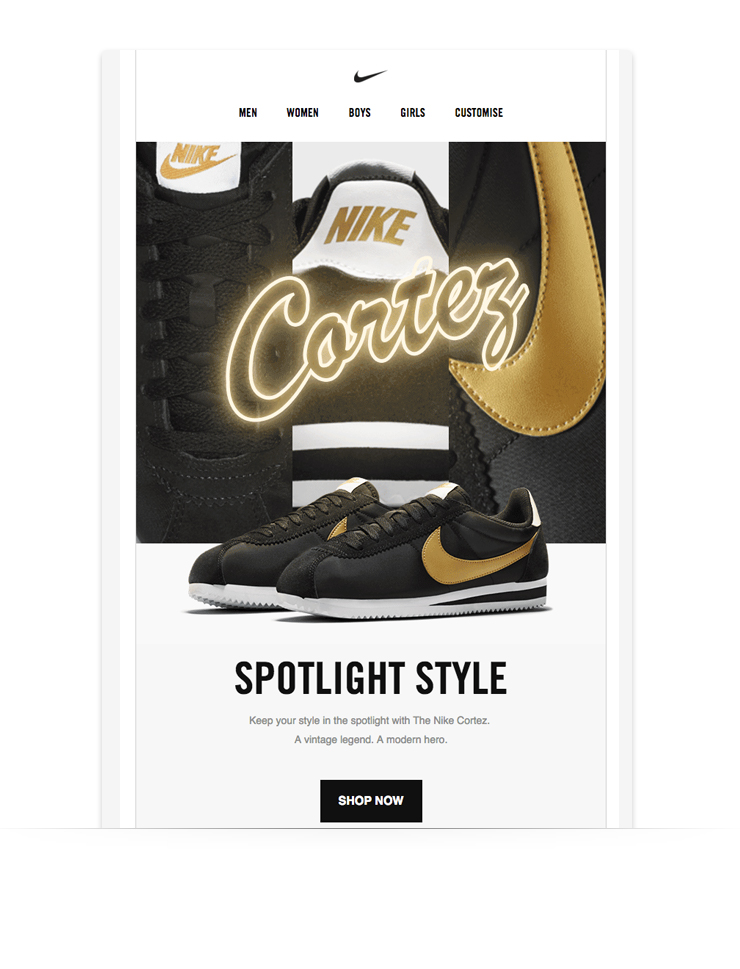
2. Be bold in your image selection
Images do more than get your brand noticed, they elicit emotion. With images, you are able to set the mood and tone of your email before subscribers even begin reading.
Related: Curious how often businesses include images in their emails? Find out inside AWeber's Email Marketing Statistics Report.
This email from The North Face is a perfect example of stunning imagery at work. Not only does the image showcase the products (waterproof rain gear), but the striking contextual image captures attention immediately:
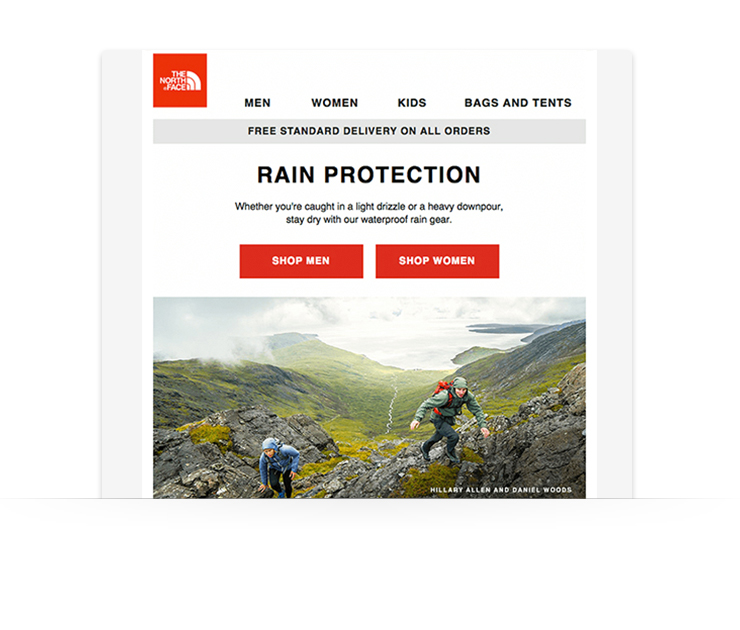
3. Utilize alt text for images
When you include images in your messages, they may or may not always display in the email clients they were sent to. That’s because many email services will disable images in messages that are sent to their users, unless the user actually verifies that they do indeed want to see the images.
Alternative text is helpful in these cases. When an image doesn’t load, a line of text will appear that describes what should be there.
Take a look at this email from Hotels.com where images were blocked, but the use of alt text was implemented.
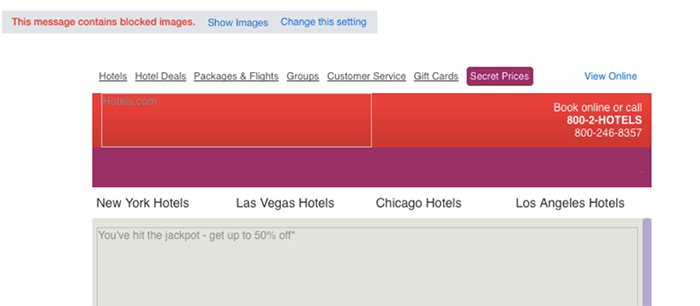
And here's what it should actually look like:
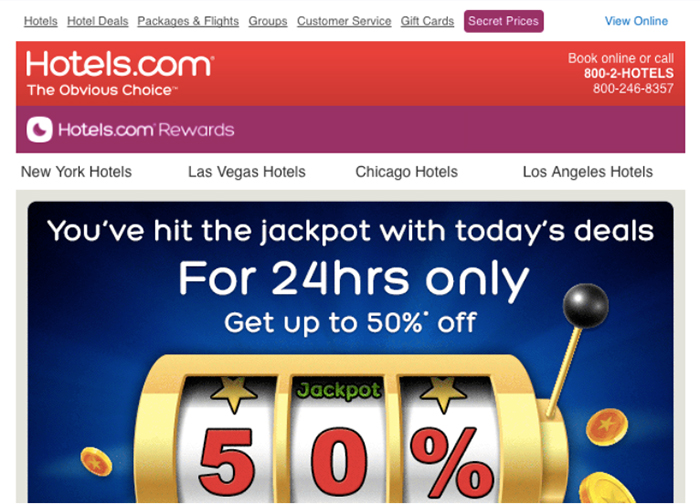
Now, you may be wondering, “Is including alt text worth my time?”
Absolutely. Forty-eight percent of mobile clients will block images by default, according to the email testing platform called Litmus. If you set up alt text, the description will appear where the images were supposed to go. If you don’t, your reader will only see blank boxes.
Alt text is also important for your subscribers with visual or certain cognitive disabilities. They may have a screen reader that will read the alt text to them so they get a full understanding of what’s included in your message.
If you are using AWeber’s Drag & Drop editor, click here to see how to set up alt text for your images.
Pro Tip: Not all images need alt text. If your image is purely for the aesthetics of the email, be sure to set an empty alt text value for the image.
Related: 3 Ways to Test Your Emails Before Hitting Send
4. Balance your text-to-image ratio
Be bold with your photos — but also limit how many you use in an email. Text-to-image ratio is how much text there is in comparison to images in your email.
There’s no such thing as the perfect “text-to-image ratio”, but most people stick with 60 percent text and 40 percent images.
Here’s why it’s important not to rely too heavily on images:
- “Image-only” emails risk going to the SPAM folder since email service providers like Gmail, Yahoo! and Hotmail tend to filter and block them.
- Images may be ‘turned off’ as default by viewers or by their email client, which means that some of your image-based navigation elements or CTAs (like buttons) may not be visible.
- Images can take longer than text to load based on browser and internet connection. A subscriber may leave the email before they’ve seen all the content.
5. Leverage contrast and whitespace
When designing your email, be sure to consider contrast and whitespace.
Images that contrast in color are not only impactful and interesting to look at, but they help ensure readers can see the images, too. Including a healthy balance of whitespace is also a design best practice that can make reading your email easier for subscribers.
Take these newsletter examples from Peloton, Flock, and Headspace. All three newsletter examples use contrasting images and include enough whitespace to make for easy reading.
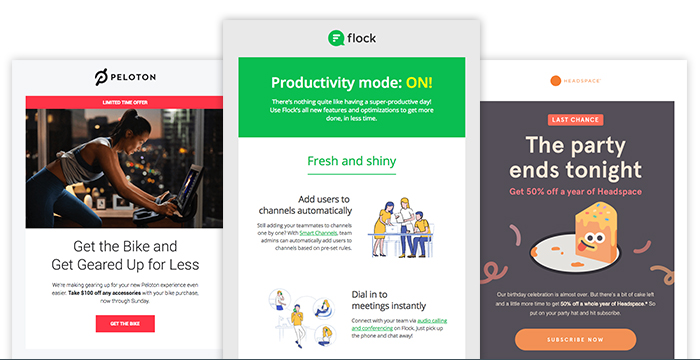
6. Keep design focused on the end goal
The email design should also be a path that leads the reader toward your ultimate goal (the CTA). To give you an idea, here is an example from Moo, a custom print and design company.
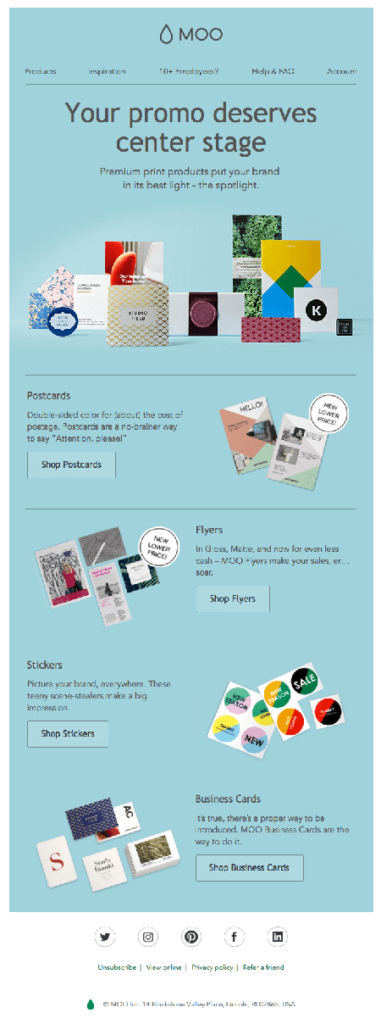
This email design works for converting readers to customers because:
- Follows a simple “Z” pattern layout, which means it easily moves your eyes in a zigzag that alternates text and images, and includes a CTA in at each "point" of the pattern.
- Consists of minimal elements and concise writing for a streamlined look.
- Includes visual examples of each product to minimize the use of long chunks of text and to show off their array of products.
- Creates defined sections for each product with the use of thin dividers.
- Contains lots of white (or in this case, blue) space to draw your attention to the images.
- Incorporates large “call to action” product buttons (i.e.: Shop Postcards) for easy navigation to their website.
7. Use big headlines and header images
You may have the world’s best headline, but if it drowns in a sea of text, no one will notice it. That’s where “visual hierarchy” comes in. You want the most important information in your message to get noticed first. Choose an increased font size and bolded text for your headline. It makes the main message in your email stand out.
Large header images evoke emotion. You’re attempting to make an connection with the viewer in the first few seconds after they open your message. The image sets a mood (happy! sad! angry!) or conveys a state of mind (hunger! relaxation!).
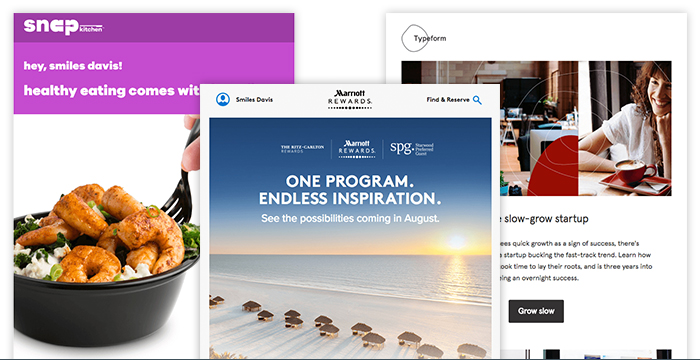
Above are three drastically different emails that give each individual brand a unique feel, predominately through their use of photographic header images. (Inside your AWeber account, use the Breve or Wane template to get started with a large header image.)
Don’t have a big budget or an in-house photographer? Here's how to create amazing custom images for your emails, social posts, ads, and websites on zero budget.
Email Newsletter Content Tips
1. Make it personalized
Customizing your email newsletters per your target audience is the secret to success.
Thanks to email segmentation, we can categorize subscribers with specific parameters and organize them into lists. Every email created should have the audience’s interests and needs at top of mind.
Customizing emails go a long way when done correctly. AWeber user and personality test company Truity has seen increased open rates as a result of their personalization efforts, including personality type-specific messages, like the one below aimed at its a specific personality type — ENFP subscribers. Truity uses the "digest" layout in AWeber's Drag and Drop Email Builder for its newsletters, giving it a streamlined, cohesive look every time it hits your inbox.
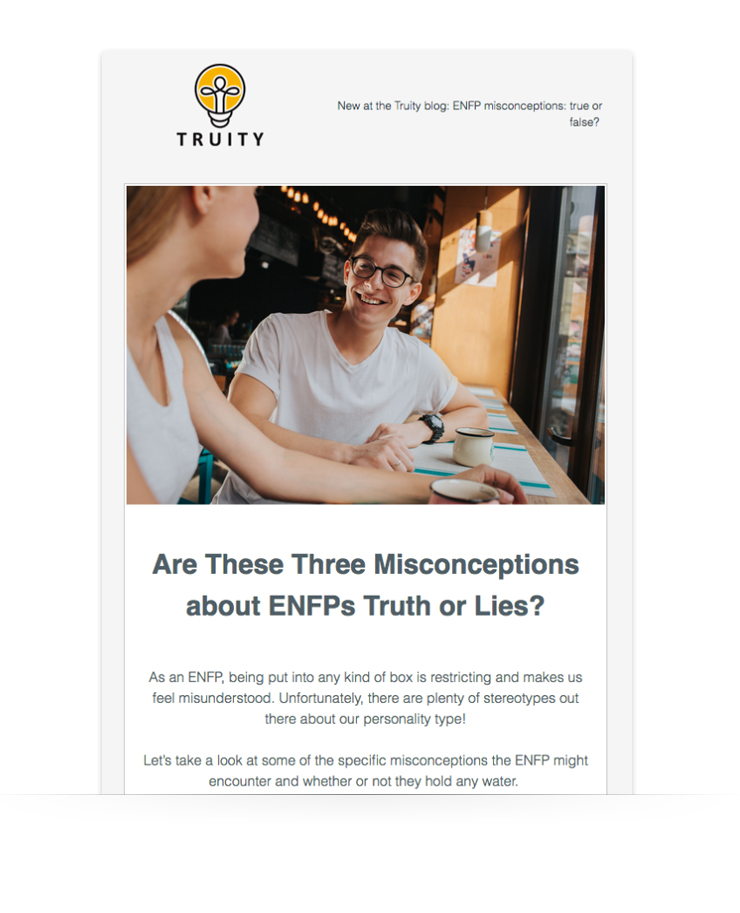
Related: Steer Clear of These Personalization Mistakes When Building Your Email
You can even personalization subject lines. This is a great way to increase open rates. Check out AWeber's Guide to Writing the World's Best Subject Lines for more ideas.
2. Short vs. long-form content
One question that marketers hear often is “how long should my email be?” The answer is, there is no right answer. Both can help you accomplish your goal and communicate your message. (Try different formats with your audience to see which ones they prefer through A/B testing.)
The InVision Weekly Digest is concise writing done right. Punchline copy delivered in an easy-to-read format.
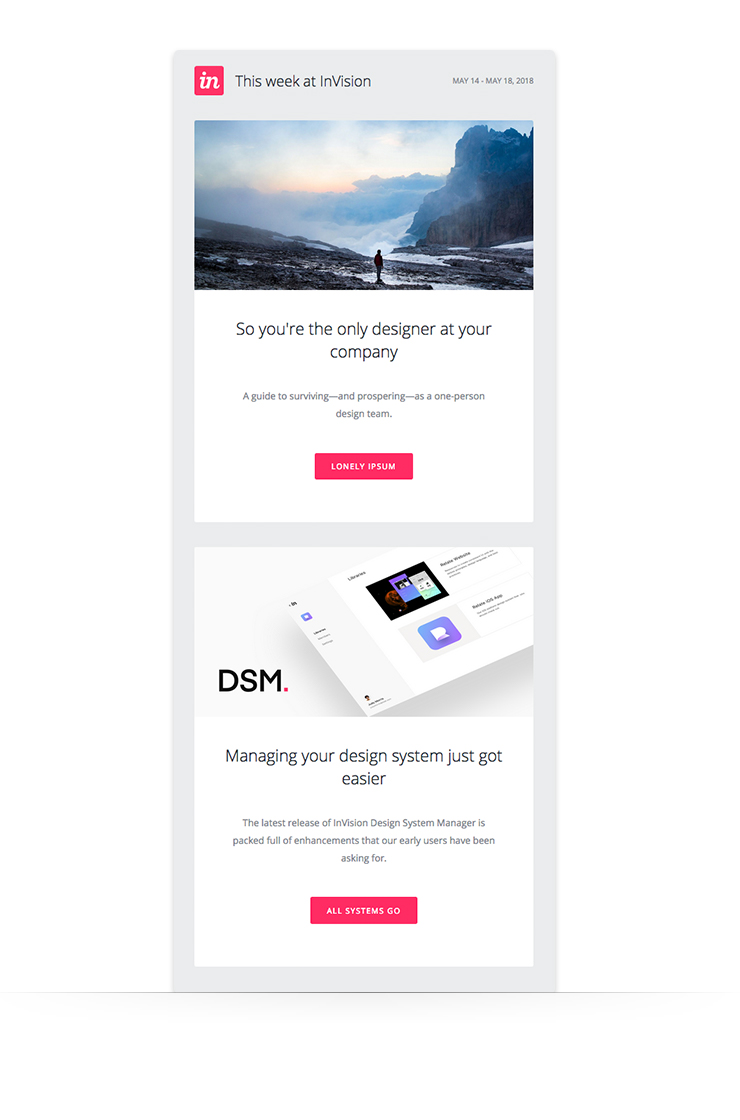
Whether you choose to create an email that’s short and sweet or something long-form, one thing stands true for both: Make it easy to read.
This rings especially true for long-form content. As we mentioned above, having a large block of text in the body of your email doesn’t do anyone any good.
Break things up into short 2-3 sentence paragraphs or use a bullet point format to convey your message.
Related: 8 Powerful Email Copywriting Techniques
Ann Handley — AWeber customer, author, and founder of Marketing-Profs, sends a bi-weekly email newsletter, Total Annarchy. It always begins with a long story. However, Handley does an excellent job of taking a ton of valuable information and presenting it in a digestible way.

3. Make your emails count
Trust is hard to gain (and easy to lose) when it comes to engaging with your customers. If someone has given you permission to his/her inbox and has opened your newsletter, it’s your time to shine.
Providing value-packed content to your subscribers is a key component in seeing a positive ROI on your email campaigns besides to growing your customer base.
WouldYouRather (WYR), another AWeber customer, does this well by making every email engaging and interactive:
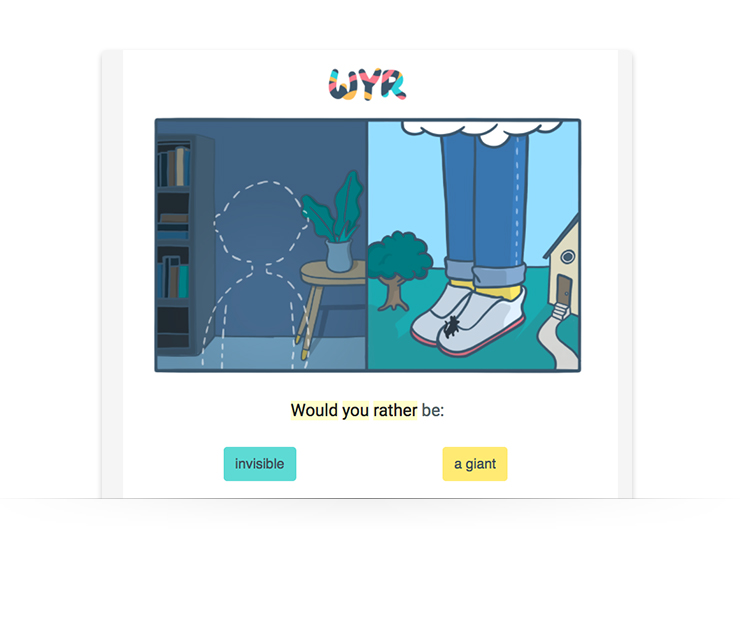
What’s more: WYR follows up with the results every week so subscribers can see what other people on their list chose (who won: compliment or a $100 bill) and why. They ask for the reasoning behind the choices made to share some insight into the human decision-making process.
Bottom line: If your content is not providing subscribers information worth their attention, leave it out of the email.
4. Special offers can lead to purchases, if done correctly
Promotional content can yield successful results, too. This is an integral part of business for those in the eCommerce world, as well as for those promoting events and selling tickets.
We see this executed well in this simple, to-the-point email from AWeber user and the band Phish:
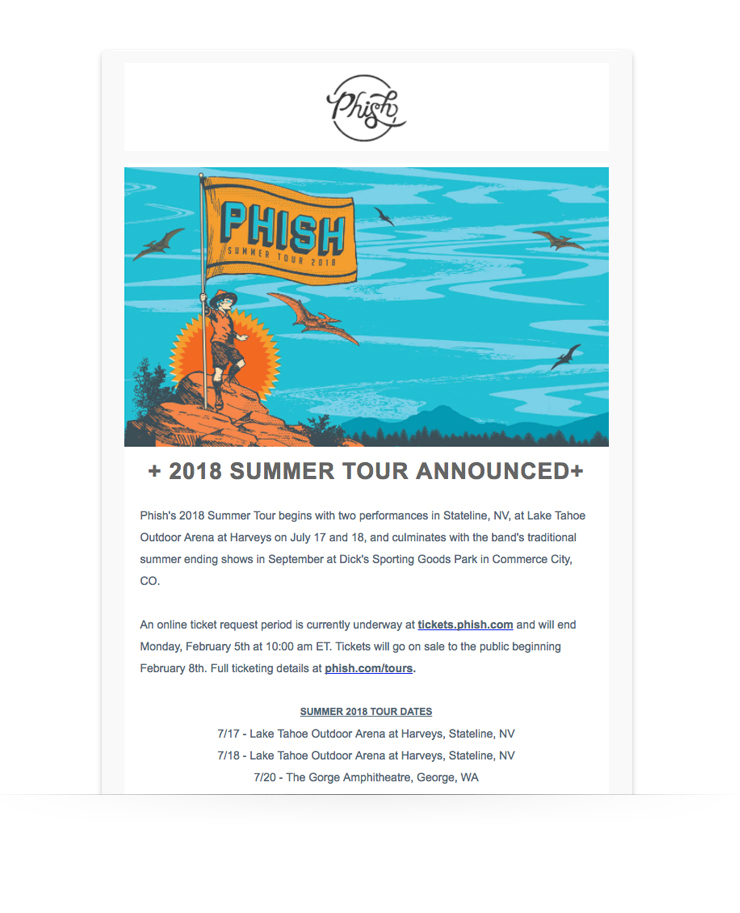
5. Be a stickler for grammar (if you aren’t already)
Mistakes happen, but if grammatical errors are consistently popping up in your email newsletters (or any of your marketing materials for that matter), you run the risk of losing your credibility, customer trust, and money.
Have an editor or a coworker with a trained eye look at the copy before adding it to your campaign. Be sure to have them check it again after you finish building the email.
If you’re an AWeber customer, it’s easy to edit copy even after you’ve entered it into your template.
Email Newsletter Content Ideas
1. Repurpose your best legacy content
Repurposing older, high-performing blog posts in your newsletter is a great way to source content, save time and drive new traffic to your best work. Consider using your evergreen content (the type that isn’t time-sensitive), such as how-to information and answers to frequently asked questions.
If there’s any recent industry news that your post could tie back to, even better. Add that fresh spin to your legacy content in your email newsletter to emphasize its timeliness and importance.
2. Interview an industry thought leader
Interviewing an expert in your field is a great way to entertain, educate, and engage your readers, while adding a fresh perspective to your email newsletters.
Ask the thought leader to promote the interview to their own audience so you can reach new subscribers to add to your email list. Just make sure you add a sign up for your newsletter inside the interview so people know how to join!
3. Feature loyal readers and customers
Just as you can interview and feature high-profile thought leaders within your industry, try doing the same for your loyal readers.
In many cases, your readers might better relate to the success story of a person who doesn’t have as much klout as an influencer. Their success might feel more attainable, even if it’s not on the same scale as an influencer.
Need a quicker way to feature customers? You might want to consider sharing user-generated content from your subscribers, such as social posts.
In Paleo Pete’s email newsletter, he shares Instagram images tagged by his readers.
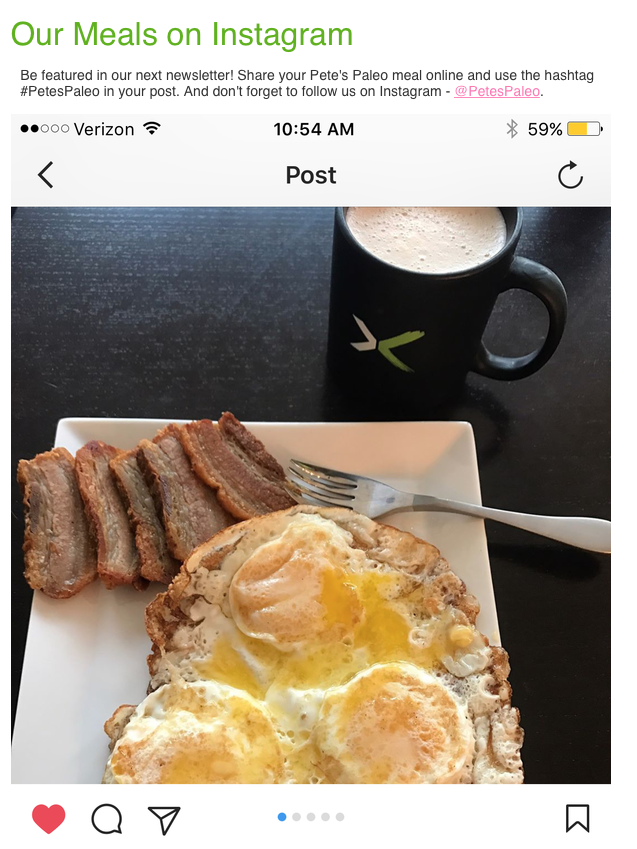
4. Add videos and interactive content
Most email clients — like Gmail and Outlook — won’t play video within a message, so you have to link to a hosted video outside of your email.
But you can include links to videos that look like you could play them within the email. It’s a creative way to deliver motion pictures and get your readers to click and watch.
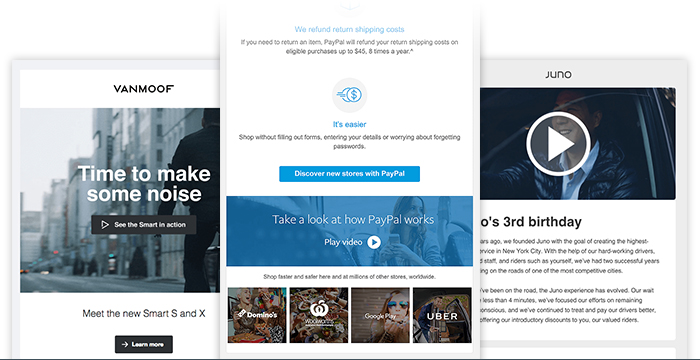
Interactive and dynamic content is also a fantastic way to engage with your readers. See how you can do this inside your AWeber account with AMP for email.
More inspiration: newsletter examples
The examples below are grouped by category so you can find what’s most relevant to you.
Newsletter Example: Blogs
Leading with a strong image and captivating copy is a sure-fire way to keep your subscribers reading. The example (hey, that’s us!) below does just that:
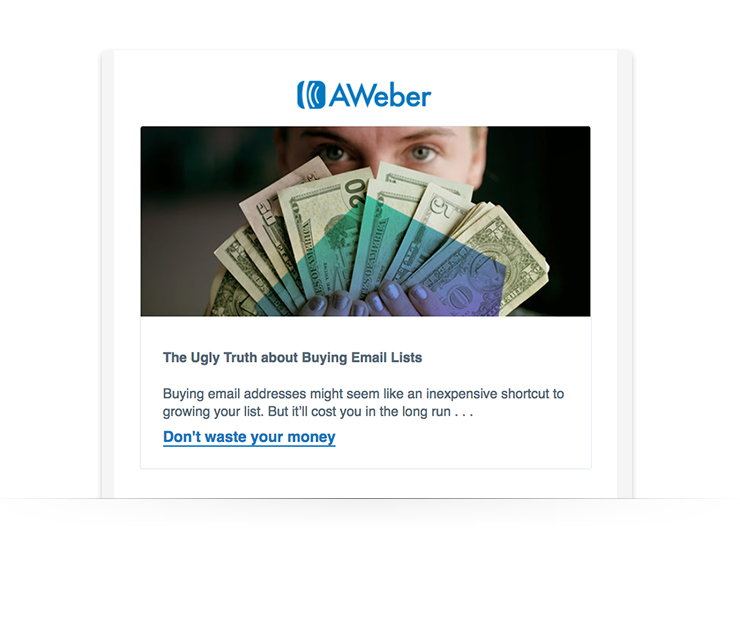
(Gain a competitive edge: Subscribe to AWeber's newsletter. Get essential tips and news about email marketing sent weekly to your inbox.)
Newsletter Example: Local and small businesses
Showcase your products or services with an email template that is visual and text-friendly. This email from Moo does a great job of highlighting a product sale in a colorful way that is not only on-brand but also eye-catching.

Newsletter Example: Podcasts
Podcasts tend to cover a lot of information during each episode. What better way to create a centralized place where listeners can do further research, learn more, or read up on guests than with a summary email?
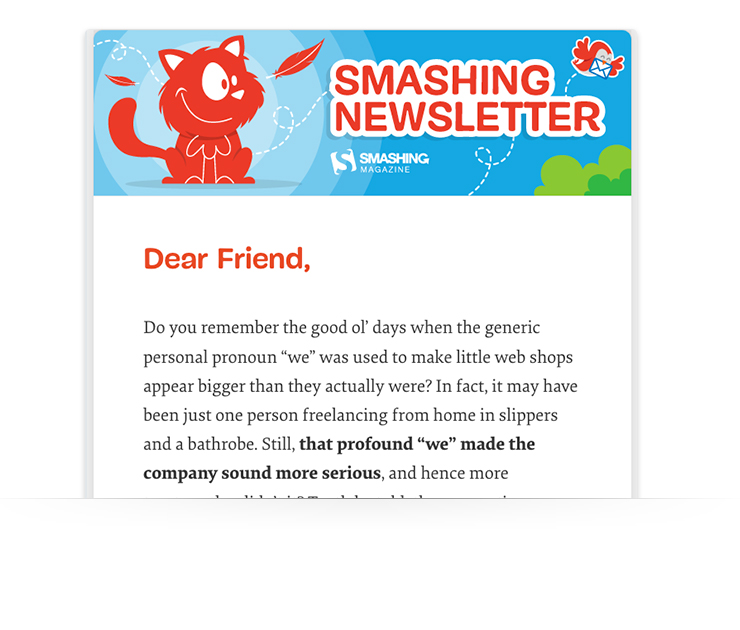
This email from Smashing Magazine includes a table of contents that make jumping sections a breeze. With an organized layout and plenty of space for a recap, this format is perfect for podcasts.
Newsletter Example: SaaS and Software Companies
Providing value to your subscribers, in whatever capacity that may be, is crucial to keeping them interested.
Including helpful content like this “How to Use Instagram Stories Templates” guide from Later is a great way to provide value. This also shows subscribers you know what you’re talking about.

Newsletter Example: Non-Profit Organizations
The Human Rights Campaign knows how to welcome new supporters. This email not only includes a thank you note, but it also outlines how supporters can take further steps to help the campaign.
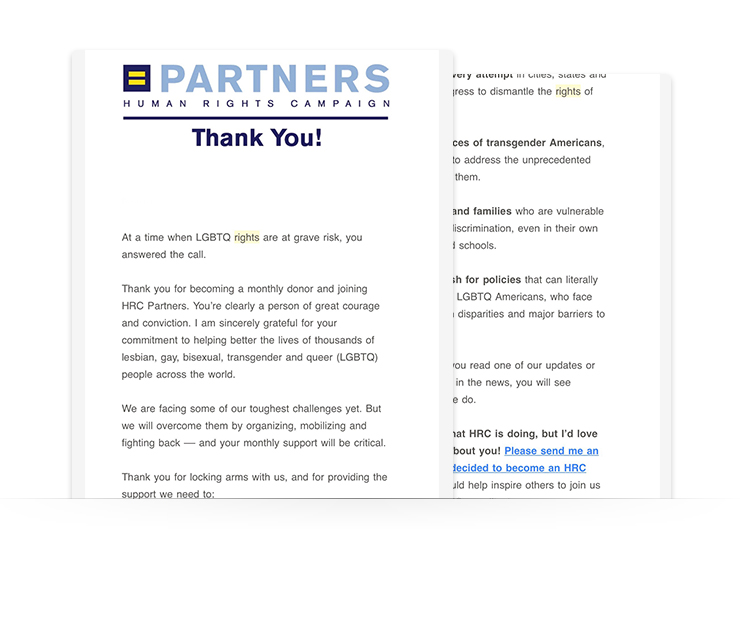
Newsletter Example: Product and eCommerce
Like the SaaS example above, product and eCommerce companies can provide value with actionable content, all while keeping things fun and interesting:
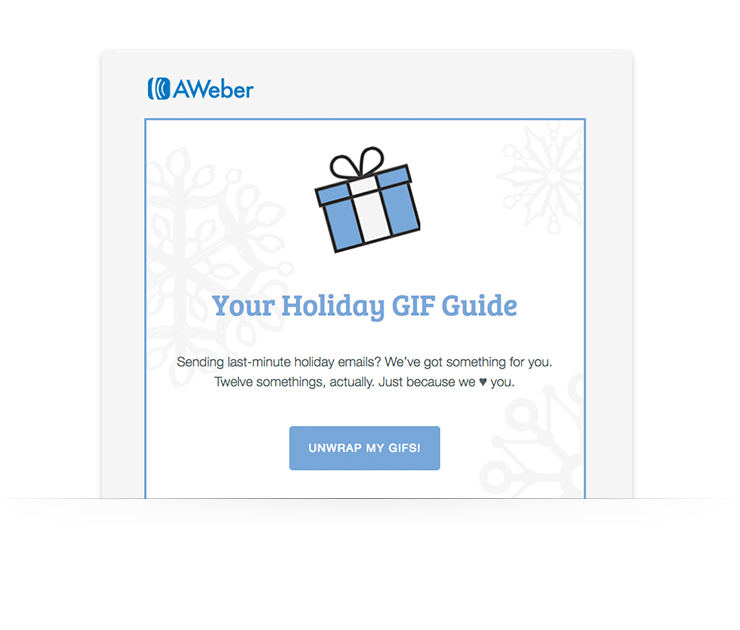
Now it’s your turn
With all this good information, now you’re ready to knock out your next email newsletter. Maybe you’ve selected your template, but aren’t quite sure what to include in each section.
No problem. We’ve broken down what the layout of your email newsletter could look like.
- Title - [Your Brand Name]’s [Weekly | Monthly | etc.] Newsletter
- Paragraph 1 - This is a great place to summarize your company and explain why you’re great. Be sure to include the most important information in this section. If you’re sending a welcome note to new subscribers, add details on how often they can expect to receive your newsletter.
- Paragraph 2 - Leverage your template by selecting bold imagery that is not only on par with the content of your email but also with your brand.
- Paragraph 3 - Time to let your writing chops shine. The goal of your email will most likely determine the length of your copy. It’s important that your email reads the same as the rest of your marketing materials, so keeping your brand style guide close is a good idea.
Building Your Email Newsletters
Your email newsletter is your opportunity to inform, educate, and connect with potential customers. Your subscribers have granted you permission to show up in their inboxes whenever you please — so now it’s time to get to work.
Let’s recap what we just learned:
- Providing value-packed content to readers is essential when it comes to the success of your campaign.
Formatting your email for readability will make or break your click-through rates. - Leveraging your segmented email lists correctly through customization will increase your ROI.
- Creating an email design that is eye-catching and functional will keep subscribers reading.
- Writing attention-grabbing copy that communicates your message goes a long way.
Want to get started on your next email newsletter? Sign up for AWeber Free to get started with email marketing at no cost!
source https://blog.aweber.com/email-marketing/newsletter-examples-how-to-craft-irresistible-newsletter-content.htm
No comments:
Post a Comment